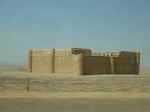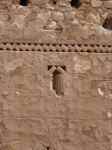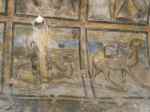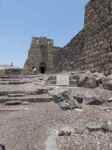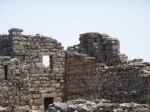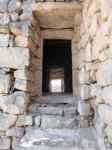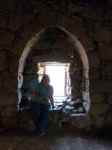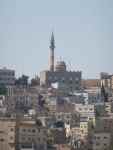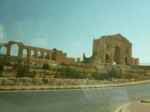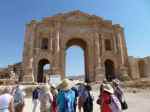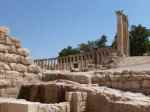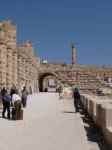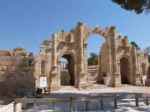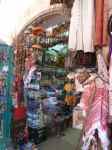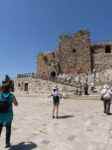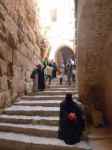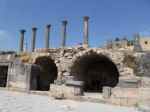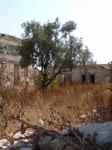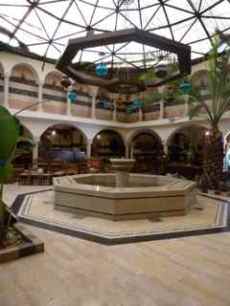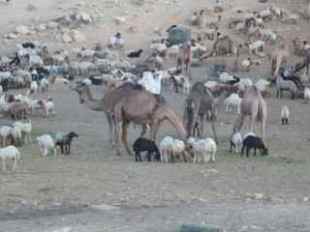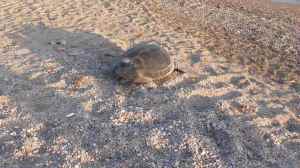Wednesday July 11, 2012
Again we loaded up our bus at 9 a.m., this time to the eastern desert in search of the desert castles. A largely unpopulated area, this stretches for miles. We saw few cars on the road, and only a few more tankers and trucks. It was easy to imagine the past here in the expanses of emptiness. Surprisingly, though, the desert is streaked black, for again the region is rich in basalt.
The desert castles are not castles in the European sense at all. Instead, they are the ruins of caravanserais (places where traders stopped with a line of camels laden with trade goods), hunting lodges, or forts. These date back to 661-750 C.E., to the Umayyads of Damascus. Once they were richly decorated, but now show us only the hints of what once must have been pleasure palaces of sorts. They also served as stopping places for pilgrims on the way to Mecca.
Quite different from each other in style and decoration, the three castles fascinated me.
First was Qasr Kharana, sitting in the middle of a barren landscape. Once a caravanserai, the building had a lower floor with stable areas for horses and camels and a fountain or basin. The upper rooms were for sleeping. In all, there were about 60 rooms.
Now it’s still possible to walk through the lower area, climb stairs to the upper level, and wander through low doorways into many of the rooms. Some are plain; all are small. The most amazing room, though, was one called The Graffiti Room. First of all, it’s vaulted and line with carved medallions. Second, it’s filled with Arabic script – inscriptions that fill walls and frame doorways. I loved this castle perhaps the most of all, for its stark lines and simple beauty.
The second stop was Qusayr Amra, built about 711 C.E. “Qusayr” means “little castle.” Part of a complex that included a bathhouse, a hunting lodge, and a caravanserie, Qusayr Amra is one of the best-preserved of the desert structures. It is also a Unesco World Heritage Site.
Though now it sits in a parched landscape, in ancient times it was next to a very lush wadi filled with pistachio trees. There was plenty of water at that time, and there is still a 25-meter-deep masonry-lined well to show that.
Walking up to the structure, you can see the walls of other areas, and the bath. Nothing really prepares you for what waits for you – wall-to-floor frescos of hunting scenes but also scenes of partying. These are not typical frescoes for this culture at all; those would depict devoted Muslims ascending to the Kingdom of Heaven. Very hedonistic and risqué, it’s clear that they are evidence that the isolation of the site provided some measure of escape from the strictures of religion. Hunters could relax and enjoy the 8th century frescoes. I even noticed a bear playing an oud, a stringed instrument – someone had a sense of humor!
The third desert castle isn’t isolated; it’s in a town that seems like a series of truck stops. This one, though, has history that is close to us. Here is where T.E. Lawrence – Lawrence of Arabia – stayed in WWI. From here he launched an attack against the Turks in Damascus. Now I want to read Lawrence’s The Seven Pillars of Wisdom. In a few days, I knew, I’d be in Wadi Rum, where Lawrence once was, seeing those very pillars, and being in the place where Lawrence of Arabia was filmed.
I walked around the inside of the walled area, but concentrated on the room where Lawrence stayed for a while. To be in the actual room, to sit and look out the window as he must have — a remarkable experience, at least for me.
- Castle Goodies, Qasr Kharana
- Qasr Kharana
- Qasr Kharana 2
- Into Qasr Kharana
- Entering Qasr Kharana
- Stairway Qasr Kharana
- The Graffiti Room, Qasr Kharana
- Detail on Wall of Qasr Kharana
- Cheryl in Graffiti Room, Qasr Kharana
- Qusayr Amra
- Outside Qusayr Amra
- Keeper of the Door, Qusayr Amra
- Wall Mosaic, Qusayr Amra
- Very Risque Wall Fresco, Qusayr Amra
- Ceiling Fresco, Qusayr Amra
- Bear Playing Oud, Qusayr Amra
- Azraq Castle
- Inside the Azraq Castle Courtyard
- Into T.E, Lawrence’s Room, Qasr Azraq
- Cheryl Sits in Lawrence’s Room, Qasr Azrak
- Another View Inside Lawrence’s Room, Azraq Castle
Back to Amman, it was time to pack. After drinks and dinner, I did just that.


